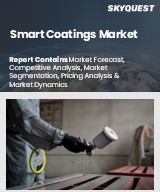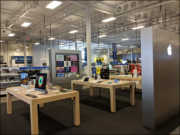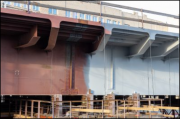
|
시장보고서
상품코드
1796475
스마트 코팅 시장 규모, 점유율, 성장 분석 : 층 유형별, 기능별, 최종사용자별, 지역별 - 산업 예측(2025-2032년)Smart Coatings Market Size, Share, and Growth Analysis, By Layer Type (Single Layer Coatings, Multi-Layer Coatings), By Function (Anti-corrosion, Anti-fouling), By End User, By Region - Industry Forecast 2025-2032 |
||||||
세계 스마트 코팅 시장 규모는 2023년에 44억 달러로 평가되었으며, 2024년 53억 7,000만 달러에서 2032년에는 265억 4,000만 달러로 성장하여 예측 기간(2025-2032년) 동안 CAGR 22.1%로 성장할 전망입니다.
세계 스마트 코팅 시장은 자동차, 건설, 항공우주 분야에서 첨단 다기능 코팅에 대한 수요 증가로 인해 크게 성장하고 있습니다. 나노기술의 혁신과 환경 친화적인 저 VOC 솔루션의 추진은 시장을 활성화시키는 중요한 요인으로 작용하고 있습니다. 스마트 코팅은 자기복원성, 내식성, 에너지 효율을 제공하며, 안전과 성능을 중시하는 용도에 필수적입니다. IoT 기술의 통합은 실시간 모니터링을 용이하게 하고, 이러한 코팅의 기능을 향상시킵니다. 그러나 원자재 가격 상승, 제조의 복잡성, 나노소재에 대한 우려 등의 문제가 보급의 걸림돌로 작용하고 있습니다. 또한, 신흥국 시장에서는 전문 지식이 제한적이기 때문에 특히 고도의 지식과 훈련이 필요한 특수한 건설 분야에서 성장을 저해하고 있습니다.
목차
소개
- 조사 목적
- 조사 범위
- 정의
조사 방법
- 정보 조달
- 2차와 1차 데이터 방법
- 시장 규모 예측
- 시장 가정과 제한
주요 요약
- 세계 시장 전망
- 공급과 수요 동향 분석
- 부문별 기회 분석
시장 역학과 전망
- 시장 개요
- 시장 규모
- 시장 역학
- 성장 촉진요인과 기회
- 성장 억제요인과 과제
- Porters 분석
주요 시장 인사이트
- 핵심성공요인
- 경쟁 정도
- 주요 투자 기회
- 시장 생태계
- 시장 매력 지수(2024년)
- PESTEL 분석
- 거시경제 지표
- 밸류체인 분석
- 가격 분석
스마트 코팅 시장 규모 : 층 유형별 & CAGR(2025-2032년)
- 시장 개요
- 단층 코팅
- 다층 코팅
스마트 코팅 시장 규모 : 기능별 & CAGR(2025-2032년)
- 시장 개요
- 내부식성
- 방오
- 항균제
- 자가 치유
- 셀프 클리닝
- 방빙 코팅
스마트 코팅 시장 규모 : 최종사용자별 & CAGR(2025-2032년)
- 시장 개요
- 자동차
- 운송
- 해양
- 건설
- 항공우주 및 방위
- 헬스케어
스마트 코팅 시장 규모 & CAGR(2025-2032년)
- 북미
- 미국
- 캐나다
- 유럽
- 독일
- 스페인
- 프랑스
- 영국
- 이탈리아
- 기타 유럽
- 아시아태평양
- 중국
- 인도
- 일본
- 한국
- 기타 아시아태평양
- 라틴아메리카
- 브라질
- 기타 라틴아메리카
- 중동 및 아프리카
- GCC 국가
- 남아프리카공화국
- 기타 중동 및 아프리카
경쟁 정보
- 상위 5개사의 비교
- 주요 기업의 시장 포지셔닝(2024년)
- 주요 시장 기업이 채용한 전략
- 최근의 시장 동향
- 기업의 시장 점유율 분석(2024년)
- 주요 기업 개요
- 기업 상세
- 제품 포트폴리오 분석
- 기업 부문별 점유율 분석
- 매출 전년비 비교(2022-2024년)
주요 기업 개요
- PPG Industries Inc.(USA)
- AkzoNobel N.V.(Netherlands)
- The Sherwin-Williams Company(USA)
- Axalta Coating Systems(USA)
- Hempel Group(Denmark)
- Jotun Group(Norway)
- 3M Company(USA)
- BASF SE(Germany)
- DuPont de Nemours, Inc.(USA)
- Covestro AG(Germany)
- NEI Corporation(USA)
- RPM International Inc.(USA)
- Nippon Paint Holdings Co., Ltd.(Japan)
- Kansai Paint Co., Ltd.(Japan)
- Valspar Corporation(USA)
- Tiger Coatings GmbH & Co. KG(Austria)
- Sika AG(Switzerland)
- Bayer AG(Germany)
- Kraton Polymers(USA)
- Behr Process Corporation(USA)
결론과 제안
KSM 25.09.03Global Smart Coatings Market size was valued at USD 4.4 billion in 2023 and is poised to grow from USD 5.37 billion in 2024 to USD 26.54 billion by 2032, growing at a CAGR of 22.1% during the forecast period (2025-2032).
The global smart coatings market is experiencing significant growth driven by the rising demand for advanced, multifunctional coatings across automotive, construction, and aerospace sectors. Innovations in nanotechnology and the push for environmentally friendly, low-VOC solutions are crucial market enablers. Smart coatings offer self-healing, corrosion resistance, and energy efficiency, which are critical for applications focusing on safety and performance. The integration of IoT technology facilitates real-time monitoring and enhances the functionality of these coatings. However, challenges such as high raw material costs, manufacturing complexity, and concerns related to nanomaterials pose barriers to widespread adoption. Additionally, limited expertise in developing markets hinders growth, particularly in specialized construction applications that necessitate advanced knowledge and training.
Top-down and bottom-up approaches were used to estimate and validate the size of the Global Smart Coatings market and to estimate the size of various other dependent submarkets. The research methodology used to estimate the market size includes the following details: The key players in the market were identified through secondary research, and their market shares in the respective regions were determined through primary and secondary research. This entire procedure includes the study of the annual and financial reports of the top market players and extensive interviews for key insights from industry leaders such as CEOs, VPs, directors, and marketing executives. All percentage shares split, and breakdowns were determined using secondary sources and verified through Primary sources. All possible parameters that affect the markets covered in this research study have been accounted for, viewed in extensive detail, verified through primary research, and analyzed to get the final quantitative and qualitative data.
Global Smart Coatings Market Segments Analysis
Global Smart Coatings Market is segmented by Layer Type, Function, End User and region. Based on Layer Type, the market is segmented into Single Layer Coatings and Multi-Layer Coatings. Based on Function, the market is segmented into Anti-corrosion, Anti-fouling, Antimicrobial, Self-healing, Self-cleaning and Anti-icing coatings. Based on End User, the market is segmented into Automotive, Transportation, Marine, Construction, Aerospace and Defense and Healthcare. Based on region, the market is segmented into North America, Europe, Asia Pacific, Latin America and Middle East & Africa.
Driver of the Global Smart Coatings Market
The Global Smart Coatings market is being propelled by advancements in nanotechnology, which significantly enhance the functionality of these coatings. Innovations in this field enable the development of smart coatings with features such as self-healing properties, antimicrobial resistance, and responsiveness to environmental stimuli. These enhanced functionalities not only improve the durability and efficiency of coatings but also cater to diverse industries, including aerospace and electronics. The integration of nanotechnology is broadening the range of applications for smart coatings, thereby driving substantial growth and expansion within the market as industries increasingly seek innovative solutions for their coating needs.
Restraints in the Global Smart Coatings Market
Manufacturers in the Global Smart Coatings market face significant challenges due to stringent regulations regarding chemical composition and the associated health risks of nanomaterials. The need to comply with these regulations often results in costly and time-consuming processes, which can delay product approvals and elevate expenses. Such obstacles hinder the speed of innovation and restrict the introduction of new formulations, consequently impeding market penetration, especially in sectors that are heavily regulated and prioritize safety. This combination of regulatory pressures and economic burdens creates a barrier that impacts the overall growth and advancement within the smart coatings industry.
Market Trends of the Global Smart Coatings Market
The global smart coatings market is witnessing a dynamic shift toward the integration of IoT and sensor-based technologies, facilitating real-time monitoring of critical surface conditions such as corrosion, temperature fluctuations, and microbial activity. This convergence enhances predictive maintenance capabilities, allowing industries like aerospace, construction, and manufacturing to significantly improve operational safety and asset longevity while minimizing downtime. As organizations increasingly prioritize efficiency and sustainability, the demand for advanced smart coatings that incorporate these cutting-edge technologies is expected to grow, positioning smart coatings as essential components in maintaining the integrity and performance of various applications across multiple sectors.
Table of Contents
Introduction
- Objectives of the Study
- Scope of the Report
- Definitions
Research Methodology
- Information Procurement
- Secondary & Primary Data Methods
- Market Size Estimation
- Market Assumptions & Limitations
Executive Summary
- Global Market Outlook
- Supply & Demand Trend Analysis
- Segmental Opportunity Analysis
Market Dynamics & Outlook
- Market Overview
- Market Size
- Market Dynamics
- Drivers & Opportunities
- Restraints & Challenges
- Porters Analysis
- Competitive rivalry
- Threat of substitute
- Bargaining power of buyers
- Threat of new entrants
- Bargaining power of suppliers
Key Market Insights
- Key Success Factors
- Degree of Competition
- Top Investment Pockets
- Market Ecosystem
- Market Attractiveness Index, 2024
- PESTEL Analysis
- Macro-Economic Indicators
- Value Chain Analysis
- Pricing Analysis
Global Smart Coatings Market Size by Layer Type & CAGR (2025-2032)
- Market Overview
- Single Layer Coatings
- Multi-Layer Coatings
Global Smart Coatings Market Size by Function & CAGR (2025-2032)
- Market Overview
- Anti-corrosion
- Anti-fouling
- Antimicrobial
- Self-healing
- Self-cleaning
- Anti-icing coatings
Global Smart Coatings Market Size by End User & CAGR (2025-2032)
- Market Overview
- Automotive
- Transportation
- Marine
- Construction
- Aerospace and Defense
- Healthcare
Global Smart Coatings Market Size & CAGR (2025-2032)
- North America (Layer Type, Function, End User)
- US
- Canada
- Europe (Layer Type, Function, End User)
- Germany
- Spain
- France
- UK
- Italy
- Rest of Europe
- Asia Pacific (Layer Type, Function, End User)
- China
- India
- Japan
- South Korea
- Rest of Asia-Pacific
- Latin America (Layer Type, Function, End User)
- Brazil
- Rest of Latin America
- Middle East & Africa (Layer Type, Function, End User)
- GCC Countries
- South Africa
- Rest of Middle East & Africa
Competitive Intelligence
- Top 5 Player Comparison
- Market Positioning of Key Players, 2024
- Strategies Adopted by Key Market Players
- Recent Developments in the Market
- Company Market Share Analysis, 2024
- Company Profiles of All Key Players
- Company Details
- Product Portfolio Analysis
- Company's Segmental Share Analysis
- Revenue Y-O-Y Comparison (2022-2024)
Key Company Profiles
- PPG Industries Inc. (USA)
- Company Overview
- Business Segment Overview
- Financial Updates
- Key Developments
- AkzoNobel N.V. (Netherlands)
- Company Overview
- Business Segment Overview
- Financial Updates
- Key Developments
- The Sherwin-Williams Company (USA)
- Company Overview
- Business Segment Overview
- Financial Updates
- Key Developments
- Axalta Coating Systems (USA)
- Company Overview
- Business Segment Overview
- Financial Updates
- Key Developments
- Hempel Group (Denmark)
- Company Overview
- Business Segment Overview
- Financial Updates
- Key Developments
- Jotun Group (Norway)
- Company Overview
- Business Segment Overview
- Financial Updates
- Key Developments
- 3M Company (USA)
- Company Overview
- Business Segment Overview
- Financial Updates
- Key Developments
- BASF SE (Germany)
- Company Overview
- Business Segment Overview
- Financial Updates
- Key Developments
- DuPont de Nemours, Inc. (USA)
- Company Overview
- Business Segment Overview
- Financial Updates
- Key Developments
- Covestro AG (Germany)
- Company Overview
- Business Segment Overview
- Financial Updates
- Key Developments
- NEI Corporation (USA)
- Company Overview
- Business Segment Overview
- Financial Updates
- Key Developments
- RPM International Inc. (USA)
- Company Overview
- Business Segment Overview
- Financial Updates
- Key Developments
- Nippon Paint Holdings Co., Ltd. (Japan)
- Company Overview
- Business Segment Overview
- Financial Updates
- Key Developments
- Kansai Paint Co., Ltd. (Japan)
- Company Overview
- Business Segment Overview
- Financial Updates
- Key Developments
- Valspar Corporation (USA)
- Company Overview
- Business Segment Overview
- Financial Updates
- Key Developments
- Tiger Coatings GmbH & Co. KG (Austria)
- Company Overview
- Business Segment Overview
- Financial Updates
- Key Developments
- Sika AG (Switzerland)
- Company Overview
- Business Segment Overview
- Financial Updates
- Key Developments
- Bayer AG (Germany)
- Company Overview
- Business Segment Overview
- Financial Updates
- Key Developments
- Kraton Polymers (USA)
- Company Overview
- Business Segment Overview
- Financial Updates
- Key Developments
- Behr Process Corporation (USA)
- Company Overview
- Business Segment Overview
- Financial Updates
- Key Developments



















